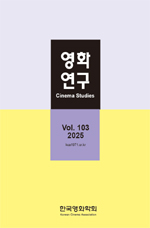- 영문명
- China’s Artistic and Cultural Acceptance of Japanese Cinema in the Era of Reform and Opening-up
- 발행기관
- 한국영화학회
- 저자명
- 채경훈(Kyeonghun Che)
- 간행물 정보
- 『영화연구』제103호, 493~527쪽, 전체 35쪽
- 주제분류
- 예술체육 > 예술일반
- 파일형태
- 발행일자
- 2025.03.23
7,000원
구매일시로부터 72시간 이내에 다운로드 가능합니다.
이 학술논문 정보는 (주)교보문고와 각 발행기관 사이에 저작물 이용 계약이 체결된 것으로, 교보문고를 통해 제공되고 있습니다.

국문 초록
본 연구는 중국 개혁개방 시기 일본영화 수용 과정에서 중국 대중문화와 영화산업에 미친 영향 및 그 역사적 배경을 다루는 것을 목적으로 한다. 이러한 연구를 통해 현대 중국영화를 이해하기 위한 또 다른 측면을 제시하고자 한다. 이를 위해 먼저 문화대혁명 시기 중국영화를 살펴보고, 개혁개방 시기 일본영화가 중국의 사회와 영화계에 미친 영향을 규명한다.
문혁기 중국영화는 정치적 목적에 부합하여 삼돌출 원칙만을 지켜야 하는 극도로 제한된 환경에서 교조적 방식으로 제작됐다. 결국 영화산업은 크게 후퇴할 수밖에 없었고, 문혁 종식 이후에도 이러한 방식에서 크게 벗어나지 못했다. 그러나 개혁개방과함께 자본주의 국가의 영화로는 일본영화가 처음으로 중국에서 소개되면서 영화에 대한 중국인들의 시각을 일변시켰고, 이에 자극을 받은 중국 영화계 또한 혁신을 시도한다.
문혁 종식 직후 일본영화는 고도로 발달한 도시와 이를 배경으로 한 자유연애, 그리고 자본주의 비판과 역사 반성부터 화려한 액션과 성적 묘사까지 자본주의 국가의 최신 영화로서 중국에 수용됐다. 중국영화에 비해 유려하고 세련된 양식의 일본영화는 특히 문혁 시기 결코 경험할 수 없었던 시각적 체험을 선사하며 큰 인기를 얻었다. 또한 다카쿠라 겐, 나카노 료코 등과 같은 일본 배우들이 큰 인기를 얻으며 사회현상으로까지 나타났다. 일본영화는 평단과 영화인들에게도 신선한 충격을 선사하며, 중국 4세대 감독들에게는 새로운 영화적 언어와 기법을 제시했으며 5세대 감독들에게도 예술적 자극을 선사하며 중국영화의 현대화를 촉진했다. 이를 계기로 중일 간의 영화 교류의 활로가 열리며 일본은 중국의 개혁개방 시기 가장 중요한 동료가 됐다.
영문 초록
This study aims to examine the historical background and the impact of Japanese films during China’s Reform and Opening-Up era on Chinese popular culture and the film industry. By doing so, it seeks to present an additional perspective for understanding modern Chinese cinema. To achieve this, the study first explores Chinese films during the Cultural Revolution period and then investigates the influence of Japanese films on China and the Chinese film industry during the Reform and Opening-Up era.
Chinese cinema during the Cultural Revolution was produced in a highly restrictive environment, adhering strictly to the “Three Prominences” principle to serve political purposes. This led to significant setbacks in the film industry, which struggled to move beyond these constraints even after the Cultural Revolution ended. However, with the advent of the Reform and Opening-Up era, Japanese films became the first from a capitalist country to be introduced in China, revolutionizing the way Chinese people viewed cinema and inspiring innovations within the Chinese film industry.
Japanese films, showcasing the highly developed urban landscapes of capitalist societies and featuring themes such as free romance, action, and even subtle sexual depictions with elegance and sophistication, provided Chinese audiences with visual experiences that were entirely absent from films during the Cultural Revolution. These films, along with actors like Takakura Ken and Nakano Ryoko, who gained immense popularity and even became social phenomena, left a profound impact on China. For critics and filmmakers, Japanese films offered fresh and exciting perspectives, introducing new cinematic language and techniques to the fourth generation of Chinese directors and providing artistic inspiration for the fifth generation, thereby accelerating the modernization of Chinese cinema. Consequently, this paved the way for significant film exchanges between China and Japan, making Japan one of China’s most crucial partners during its Reform and Opening-Up era.
목차
1. 들어가는 말
2. 문혁기 교조적 중국영화
3. 도시적 삶에 대한 욕망과 일본영화
4. 일본영화에 투영된 문혁 반성과 해체
5. 나가는 말 - 개혁개방 이후 중일 영화 교류
키워드
해당간행물 수록 논문
- 영화 리터러시의 재매개를 위한 논의: 시네필리아에서 페다고지로의 전환, ‘관객 개발’
- 한국 초능력 영화의 생명정치: <마녀>를 중심으로
- 한국 재난영화의 장르 관습과 사회정치학 2009∼2016
- 메타버스의 리좀적 공간성과 그 의미: <레디 플레이어 원>(2018)
- OTT 영화의 기획 전략과 서사 구조 변화 연구 : <사냥의 시간>, <승리호>, <연애 빠진 로맨스>와 오리지널 기획 영화 <전, 란> 넷플릭스 배급 사례 분석을 중심으로
- 장르영화로서의 주선율: 내러티브 체계를 중심으로
- 다큐멘터리영화의 극영화 스타일 연구: <거미의 땅>을 중심으로
-
다큐멘터리에서의 AI 사용이 던지는 문제와 가능성: IDFA 개막작
(2024)를 중심으로 - 영화 속 장소를 통해 본 1990년대 중국 청년의 표상: <천과월량적여행(穿过月亮的旅行)>(2024)을 중심으로
- 체계적 문헌고찰을 통한 영화 제작단계의 탄소배출에 대한 해외연구 동향 및 고찰
- 하이퍼객체의 시점, 오버뷰 이미지: (포스트) 아포칼립스 장르 영화를 중심으로
- 한국형 오컬트 영화의 장르 융합 양상 연구: <곡성>과 <파묘>를 중심으로
- 영화 <콘크리트 유토피아>에서 나타나는 폭력에 대한 고찰: 르네 지라르의 욕망 이론과 희생양 메커니즘을 중심으로
- 중국 개혁개방 시기 일본영화의 문화적 수용
- 예술영화를 통해 본 김정은시대 북한 영화의 변화 양상
- <플란다스의 개>(2000)에 나타난 자기반영성과 봉준호의 영화적 자의식:‘구라풀기(Fabulieren)’와 ‘슬랩스틱(slabstick)’을 중심으로
참고문헌
관련논문
예술체육 > 예술일반분야 BEST
- 생성형 AI 도구와 디자이너의 협업 프로세스 개발 - 이미지를 통한 아이디어 확산에서 고해상도 렌더링까지
- 디자인 전공 교과목에서의 생성형 AI 도구 활용 사례 연구
- ‘일과 삶의 균형(Work-Life Balance)’ 척도 개발을 위한 연구
예술체육 > 예술일반분야 NEW
- 한국영화의 촬영과 조명 시리즈 2: 영화 '형사, Duelist'의 Visual Concept 및 조명플랜
- 포스트모더니즘적 영상표현에 관한 연구 -실사 영화와 애니메이션 영화의 상호작용을 중심으로-
- 소니 HVR-Z1N 카메라의 중요한 메뉴에 관한 소고
최근 이용한 논문
교보eBook 첫 방문을 환영 합니다!

신규가입 혜택 지급이 완료 되었습니다.
바로 사용 가능한 교보e캐시 1,000원 (유효기간 7일)
지금 바로 교보eBook의 다양한 콘텐츠를 이용해 보세요!


